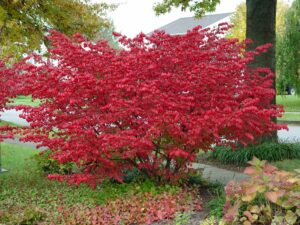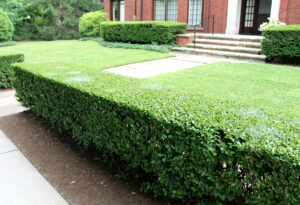Goodbye Burning Bush and Privet
December 6th, 2022
Five more invasive landscape plants are about to bite the dust in Pennsylvania.

Burning bushes are to be phased out of sale in Pennsylvania for being invasive.
Come Jan. 10, the state Department of Agriculture is adding burning bush and four species of privets (the Japanese, European, Chinese, and border types) to the state’s Controlled Plant and Noxious Weeds list.
Burning bush is a widely planted version of euonymus that turns bright red in fall, while privet is an old-fashioned evergreen hedge plant that looks a bit like boxwood.
Both produce seeds that spread readily, where these wild and durable non-natives usually elbow out natives that are more valuable to our local wildlife and pollinators.
The burning-bush and privet bans are being phased in, meaning that remaining stocks of the plants will be available for sale until a stop-sale cutoff date.
Ag Department press secretary Shannon Powers says the department will announce the cutoff dates in January along with procedures for retailers and recommended native alternatives.
She adds that “homeowners will not be asked to remove bushes,” but they are “encouraged” to do so.
These latest plant bans are part of a state crackdown on invasive plants that began in late 2021 and early 2022 when Japanese barberries, flowering (callery) pears, ravenna grass, Japanese stiltgrass, garlic mustard, and common and glossy buckthorns were added to the noxious-weed list.
See the full list of plants on Pennsylvania’s noxious-weeds list
Powers said that Japanese barberries will be banned from sale as of Oct. 8, 2023, and flowering pears will be banned as of Feb. 10, 2024. Glossy buckthorn’s grace period ends in February 2023. (The others aren’t widely available in garden centers or aren’t sold at all.)
The Ag Department does have an exemption plan in place in cases where growers can prove they’ve developed or selected varieties that are sterile (i.e. don’t produce viable seeds).
That’s just happened with barberries. Four varieties of barberries have been exempted from the ban as being sterile varieties – the four varieties in the WorryFree series that was developed at the University of Connecticut.
Those varieties – Crimson Cutie, Lemon Cutie, Lemon Glow, and Mr. Green Genes – will be allowed to be sold in Pennsylvania garden centers and nurseries even after all other barberries are banned.

Privets also are being phased out.
Breeders are at work developing sterile varieties of other species on some states’ invasive-plant list, such as sterile butterfly bushes, sterile miscanthus grass, and sterile fountain grass.
Earlier this year, the Ag Department added three other plants to the noxious-weeds list – chocolate vine (Akebia), lesser celandine, and wild chervil. The department’s Controlled Plant and Noxious Weed Committee plans to consider adding starry stonewort and five species of non-native honeysuckles to the list at its next meeting in January.
Read more on the state’s crackdown on invasive plants
That’s likely not the end of the line either.
An advisory group to the committee last year zeroed in on 25 invasive species that have the greatest negative impact on the state’s environment and economy.
Besides the aforementioned plants, that consideration list includes butterfly bush, English ivy, Japanese maple, Japanese spirea, heavenly bamboo (Nandina), miscanthus grass, Norway maple, Japanese and Chinese wisterias, Oriental bittersweet, orange or “tawny” daylily (Hemerocallis fulva), Russian and autumn olives, wintercreeper euonymus, porcelain berry, Japanese empress tree (Paulownia), amur maple, and yellow flag iris.
See the Ag Department’s list of top 25 plants to be evaluated for the noxious-weed list
Being on the consideration list doesn’t guarantee a plant is headed for a ban, but it does mean that these are plants that at least some experts believe are problematic.
If you’d like to replace or avoid them, I wrote a PennLive.com column earlier this year on non-invasive and mostly native alternatives to 17 potentially invasive landscape plants (including barberry, callery pear, burning bush, and privet).
Read George’s column on good replacements for 17 invasive landscape plants
State Agriculture Secretary Russell Redding testified at a legislative hearing last year that invasive bugs, diseases, and plants together cause an estimated $120 billion in damages and losses per year throughout the U.S.
“Invasive plants out-compete our native plants and trees for nutrients and sunlight, resulting in dramatic changes to the composition and structure of our forests and natural areas,” Redding said. “What Penn’s Woods looks like a generation or two from now may be completely unrecognizable compared to today. After habitat loss, invasive species are the second greatest contributor to loss of biodiversity and species extinctions.”







